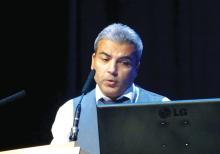BIRMINGHAM, England – More than half of all patients referred to a fast-track giant cell arteritis (GCA) clinic that offers a walk-in ultrasonography service avoided use of glucocorticoids, according to a report given at the annual conference of the British Society for Rheumatology.
The clinic, an initiative run by the University Hospital Coventry and Warwickshire (UHCW) NHS Trust for the past 6 years, provides same-day diagnosis and treatment for suspected GCA.
“Walk-in ultrasound helps to avoid steroids completely in a significant proportion of patients,” said study author and presenter Shirish Dubey, MBBS, a consultant rheumatologist at the UHCW NHS Trust. Of 652 patients seen at the UHCW GCA fast-track clinic between 2014 and 2017, 143 (22%) were diagnosed with GCA. Over 400 had not been exposed to glucocorticoids and 369 (57%) were able to avoid unnecessary glucocorticoid use in the cohort, Dr. Dubey reported.
The old NHS paradigm for managing patients with suspected GCA was that when they presented to their primary care physicians, they would be started on immediate glucocorticoid therapy while waiting for an urgent specialist referral. However, that referral could take anywhere from a couple of days to a couple of weeks to happen, Dr. Dubey explained. Patients would then undergo possible temporal artery biopsy (TAB) and only then, following confirmation of a GCA diagnosis, would a management plan be agreed upon.
UCHW introduced its fast-track pathway for the diagnosis of GCA in mid-2013. The pathway called for patients with suspected GCA aged 50 years or older who had two or more features present, such as an abrupt, new-onset headache or facial pain, scalp pain and tenderness, jaw claudication, or visual symptoms. Primary care physicians could make urgent referrals to the service via an on-call rheumatology trainee or ophthalmology senior house officer.
“Patients are normally steroid-naive and seen on the same day,” Dr. Dubey said. Doppler ultrasound of the temporal artery results in around 80% of diagnoses, with TAB still needed in some cases.
One of the downsides of the fast-track process perhaps is the increasing number of referrals. “One thing we find is that we have become a glorified headache service,” Dr. Dubey said. However, many patients do not have GCA and, when there is a low clinical probability and the ultrasound is negative, the patient is usually reassured and discharged with no need for glucocorticoids. Although the number of referrals have increased – 98 patients in 2014, 154 in 2015, 123 in 2016, and 277 in 2017 – the number of those diagnosed with GCA has remained around the same.
To see how ultrasound was faring in real-life practice, the UHCW NHS Trust team compared Doppler ultrasound findings against the final clinical diagnosis for the period 2014 to 2017. A sensitivity of just under 48% and specificity of 98% was recorded. The positive and negative predictive values were 87% and 88%, respectively.
The specificity of ultrasound was lower than that reported previously in the literature, the UHCW NHS Trust team pointed out in its abstract, but it does compare similarly with other real-world studies. The use of glucocorticoids affected the ultrasound results, with better sensitivity (55%) when these drugs were not used prior to the scan.
The use of TAB versus a clinical diagnosis in 100 patients seen over the same time period showed it had a sensitivity of 37% and a specificity of 100%, with positive and negative predictive values of 100% and 62%. The sensitivity of TAB is again low, Dr. Dubey said, but that could be because TAB is performed only when the diagnosis is uncertain.
This was an unselected cohort of patients, but overall there were good positive and negative predictive values. The UHCW NHS Trust team suggested that ultrasound can assist and reassure clinicians trying to diagnose or exclude GCA in their patients.
Regular multidisciplinary team meetings including rheumatology, ophthalmology, and vascular Doppler physiologists are key to the fast-track service, Dr. Dubey pointed out.
Despite the shortcomings of the retrospective study, Dr. Dubey stressed that the team was confident that none of the patients who had been ruled out as having GCA were subsequently diagnosed as having GCA.
Importantly, he said, the use of ultrasound had made a big difference in cost; the group plans to formally evaluate costs of ultrasound versus TAB.
The study received no commercial funding. Dr. Dubey had no conflicts of interest to disclose.
SOURCE: Pinnell J et al. Rheumatology. 2019;58(suppl 3):Abstract 038.


